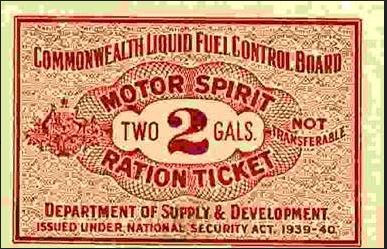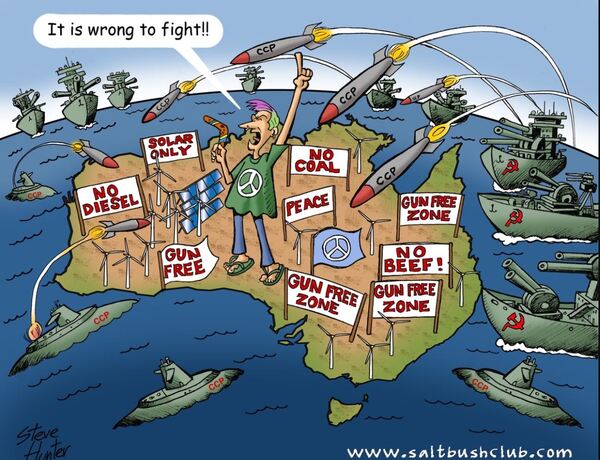
(function(d, s, id) { var js, fjs = d.getElementsByTagName(s)[0]; if (d.getElementById(id)) return; js = d.createElement(s); js.id = id; js.src = “https://connect.facebook.net/en_US/sdk.js#xfbml=1&version=v3.0”; fjs.parentNode.insertBefore(js, fjs); }(document, ‘script’, ‘facebook-jssdk’)); –>
–>
November 4, 2023
As net zero strangles Australian industry, Australia is becoming green, powerless, and defenseless.
History holds lessons which we ignore at our peril.
‘); googletag.cmd.push(function () { googletag.display(‘div-gpt-ad-1609268089992-0’); }); document.write(”); googletag.cmd.push(function() { googletag.pubads().addEventListener(‘slotRenderEnded’, function(event) { if (event.slot.getSlotElementId() == “div-hre-Americanthinker—New-3028”) { googletag.display(“div-hre-Americanthinker—New-3028”); } }); }); }
Here is some of it.
Japan was opened to trade with the U.S. in the 1850s. The Japanese were daunted by the naval power of Britain and the U.S. but determined to catch up.
In the 1930s, Japan attacked China, Mussolini attacked Ethiopia, and Hitler plotted how to avenge World War I in Europe. Britain’s prime minister, Neville Chamberlain, negotiated with Hitler and proclaimed he had achieved “Peace in our time.”
But Churchill warned:
Britain must arm. America must arm. We will surely do it in the end but how much greater the cost for each day’s delay.
In November 1938, just after the signing of the Munich Pact, John Curtin (the leader of the Labor Party in the Australian Parliament), made this statement:
‘); googletag.cmd.push(function () { googletag.display(‘div-gpt-ad-1609270365559-0’); }); document.write(”); googletag.cmd.push(function() { googletag.pubads().addEventListener(‘slotRenderEnded’, function(event) { if (event.slot.getSlotElementId() == “div-hre-Americanthinker—New-3035”) { googletag.display(“div-hre-Americanthinker—New-3035”); } }); }); }
.. . I say that any increase in defence expenditure appears to be an entirely unjustifiable and hysterical piece of panic propaganda.
Source: Hansard (British government report), page 1,095, Nov. 2, 1938.
Just ten months later, in September 1939, Germany attacked Poland.
On this side of the world, the Japanese built a large naval and air force.
However American, British and Dutch interests controlled Asian oil supplies needed for trucks, tanks, ships and planes. With Britain preoccupied with Germany, and Italy in Europe, Japan decided on a huge grab for land and resources.
In 1931 Japan occupied Manchuria and by 1937 Japanese troops were attacking Chinese soldiers outside Beijing. Japan invaded French Indochina in 1940 and a large Japanese force threatened the Philippines where U.S. General Douglas MacArthur was based.
On Monday, Dec. 8, 1941, Australian Prime Minister Curtin was told that Japanese aircraft had attacked the large U.S. Pacific Fleet at Pearl Harbor, and U.S. bases in the Philippines.
Three days later, two “invincible” British warships, “Repulse” and “Prince of Wales” were sunk by Japanese planes off what was then called Malaya. Soon Japanese armies were rampaging through Asia towards Australia. In December 1941 Hong Kong fell.
By February 1942, the British fortress of Singapore surrendered and Japanese bombs were falling on Darwin. By September 1942, the Japanese army had slashed its way down the Kokoda Track across Papua New Guinea. They could see the lights of Port Moresby and were looking across Torres Strait to Australia.
Further south, five Japanese submarines were snooping in the seas off Sydney harbor. Two midget submarines entered the harbor and one sub sank the HMAS Kuttabul. The Japanese navy later bombarded Sydney and Newcastle.
By that time, most of Australia’s trained soldiers were fighting Rommel at Tobruk in North Africa or were in Japanese prison camps. Australian politicians discussed the infamous “Brisbane Line” – surrender of Australia north of Brisbane.
Suddenly Australia was on its own and needed to defend itself with what we Australians had here.
Armies need manpower, weapons, ammunition, vehicles, tanks, planes, ships, fuel and lubricants.
Soldiers volunteered and others were conscripted. Australian conscripts formed part of the force that met the Japanese on the Kokoda Track in Papua New Guinea.
Britain lost so many weapons at Dunkirk that Australian factories and American sportsmen were sending guns to them.
Enfield Rifles, Bren Guns and Vickers Machine Guns were produced in large numbers at the Small Arms Factory at Lithgow in New South Wales supported by feeder factories in the area. Australians even designed and built the fabulous Owen Machine Gun, so loved by our young Nashos in the 1960s.
Australian coking coal was used to produce steel and thermal coal provided reliable electricity and powered locomotives. However, coal production was often interrupted by bitter strikes in the early war years. But after Hitler invaded Soviet Russia in June 1941, the communists among the coal miners suddenly became more supportive of the war effort.
Motor oil was produced in limited quantities from oil shale at Glen Davis in central NSW, but petrol was in serious short supply, and had been rationed since 1940.

Image: Viv Forbes
With the fall of Singapore, this fuel shortage became severe, and charcoal burners suddenly appeared to keep cars and trucks moving. The demand for charcoal was so great that firewood became scarce so it was also rationed. Kerosene was also scarce, so carbide lights were recovered from junk sheds and widely used.
To conserve supplies for soldiers, rationing was also introduced for tea, clothing, butter, sugar, meat and cigarettes. Australian farmers were forbidden to kill their own animals for meat (but many of them did anyhow).
Australian school kids got cards to be used to identify enemy planes overhead and fathers with picks and shovels were told to dig air raid pits in school grounds (even then I thought that our one-room Wheatvale school with 13 pupils was probably not a top priority target for Japanese bombers.)
We saw no enemy planes at Wheatvale but a bomber from our side was forced to land in our neighbor’s wheat paddock and a big convoy of American Jeeps and trucks stopped at our farm to make their morning coffee (it was the first time we ever tasted coffee).
A critical war time shortage was copper for cartridge cases and communications – Australia had mines producing lead, zinc, silver, gold and iron, but there was a critical shortage of copper.
Fortuitously, just before the Japanese attack on Pearl Harbor, an exploration drill hole at Mount Isa had struck rich copper ore.
Mount Isa was then called on to avert a calamitous shortage of copper in Australia. With government encouragement, Mount Isa Mines made the brave decision to suspend their profitable silver/lead/zinc operations and convert all mining and treatment facilities to extracting copper.
The lead concentrator could be converted to treat copper ore, but the biggest problem was how to smelt the copper concentrates. Luckily the company had skilled engineers and metallurgists in the lead smelter. In a miracle of improvisation, scrap steel and spare parts were purchased and
scavenged from old mines and smelters from Cloncurry, Mt. Elliott, Mt. Cuthbert and Kuridala and cobbled into a workable copper smelter.
In 1943, the first Mount Isa blister copper was produced. Production continued after the war when Mount Isa returned to extracting the then more profitable silver/lead/zinc. Later, new plant was built enabling both lead and copper to be produced from this fabulous mine.
This story of the importance of self-reliance has lessons for today especially at a time when the final closure of the great Mt. Isa copper mines has just been announced.
The war on carbon energy, net zero propaganda, the renewable energy targets, escalating electricity costs and the voices in Parliament calling for Emissions Trading Schemes have all unnerved our big users of carbon fuels and electricity.
Smelting and refining have become threatened industries in Australia.
‘); googletag.cmd.push(function () { googletag.display(‘div-gpt-ad-1609268078422-0’); }); document.write(”); googletag.cmd.push(function() { googletag.pubads().addEventListener(‘slotRenderEnded’, function(event) { if (event.slot.getSlotElementId() == “div-hre-Americanthinker—New-3027”) { googletag.display(“div-hre-Americanthinker—New-3027”); } }); }); } if (publir_show_ads) { document.write(“
Already six major metal smelting/refining operations have closed in Australia this century and more are likely. The closures have affected copper, lead, zinc, steel and aluminium – the sinews of modern industry. And car manufacturing, with all its skills and tools, has gone.
Local production and refining of oil is also declining, while “lock-the-gate” picketers are trying to prevent domestic exploration and production of gas. More and more land and offshore waters are closed to exploration and mining, and heavy industry is scorned.
Australia has lost over half of its oil refining capacity and most of our liquid fuel comes from foreign refineries. At normal rates of usage, national reserves of diesel would last about three weeks and ULP about four weeks. But in the event of a panic for fuel, city food shelves and fuel
supplies would be cleaned out in days, maybe hours. Commercial aircraft would be grounded in a fortnight and our Air Force soon after.
We are losing the resources, skills and machinery needed for our own security. And we fritter our declining resources on green energy white elephants like Snowy 2, green hydrogen, dream-time extension cables to transmit “green” electricity from Darwin to Singapore, hydrogen electrolyzer
magic in Gladstone, a Pioneer Valley pumped hydro scheme (Snowy 3?), massive new power lines to collect piddling energy everywhere and many other green dreams with net consumption of energy and metals.
Green admirals hope to run our destroyers on recycled cooking oil and green generals are wasting energy designing electric bushmasters (with long extension cords?). These foolish green energy policies and the suicidal war on carbon fuels are killing real industry leaving us unskilled and
defenseless – like a fat toothless walrus basking on a warm sunny beach.
And imagine the mental and physical capacity of the flabby woke recruits that an urgent conscription would produce today. And which toilet would they use? Hopefully a few bikie gangs would sign up? At least they know how to fight and could bring their own guns.
Here is our pictorial comment on the subject by Steve Hunter:

The Salt Bush Club gives permission to use this item. Feel free to publish or pass around with no alterations.
Australia plans to spend heaps of money and decades of time on AUKUS nuclear submarine dreams – another Snowy 2? Imagine the chance of getting our no-nukes mobs to build a nuclear-powered submarine in Australia that works and is launched before the barbarians are again knocking at our gate. Former Australian Prime Minister Alexander Downer describes it “A political fantasy.”
Now another Asian tiger — in Beijing — is currently gazing south at the resources locked up in Red-Black-Green Australia. Its advance guards are already installed in academia and the media.
The next war may be very short with simultaneous attacks on U.S. military installations from South Korea and Guam to Pine Gap. And imagine when our power, radar, internet, social media and electric engines are suddenly disabled with an EMP attack from a well-placed neutron bomb. And the tankers carrying our fuel supplies from Asian refineries meet a guided torpedo or an armed drone.
Our rainbow warriors with ill-chosen air and naval equipment, insufficient ammunition, rationed fuel and lubricants and half-built nuclear submarines will surrender quickly.
Wake up, Australia.
Viv Forbes is old enough to remember the end of WW2, was called up for National Service training in 1958 and also spent several years as a part-time soldier in Australia’s Citizen Military Forces. He was the founding Secretary of the Australia Defence Association in 1980 and lives in Australia.
For those who would like to read more:
“Mines in the Spinifex – the Story of Mount Isa Mines” by Geoffrey Blainey,
Angus and Robertson, 1960
“The Challenge of Standing on the Shoulders of Giants” by Collin Myers,
Congress of the International Mining History Association, Charters Towers,
2014.
“Hidden Hand” – how the Communist Party is reshaping the World by Clive
Hamilton and Mareike Ohlberg
“Danger on our Doorstep” by Ex Major General and Senator Jim Molan.
Warning: Some of the above sites may contain war-related material, including images which some of today’s wimps may find confronting and disturbing.
<!–
–>
<!– if(page_width_onload <= 479) { document.write("
“); googletag.cmd.push(function() { googletag.display(‘div-gpt-ad-1345489840937-4’); }); } –> If you experience technical problems, please write to [email protected]
FOLLOW US ON
<!–
–>
<!– _qoptions={ qacct:”p-9bKF-NgTuSFM6″ }; ![]() –> <!—-> <!– var addthis_share = { email_template: “new_template” } –>
–> <!—-> <!– var addthis_share = { email_template: “new_template” } –>





